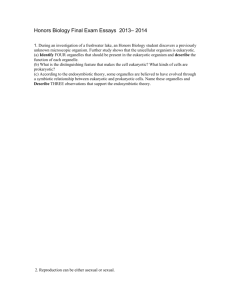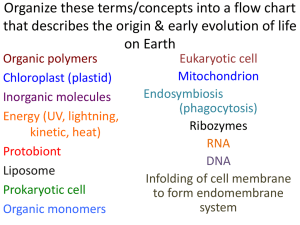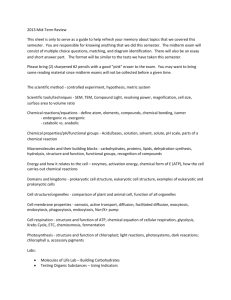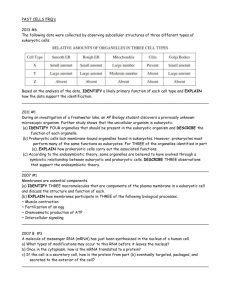eprint_2_11175_800
advertisement
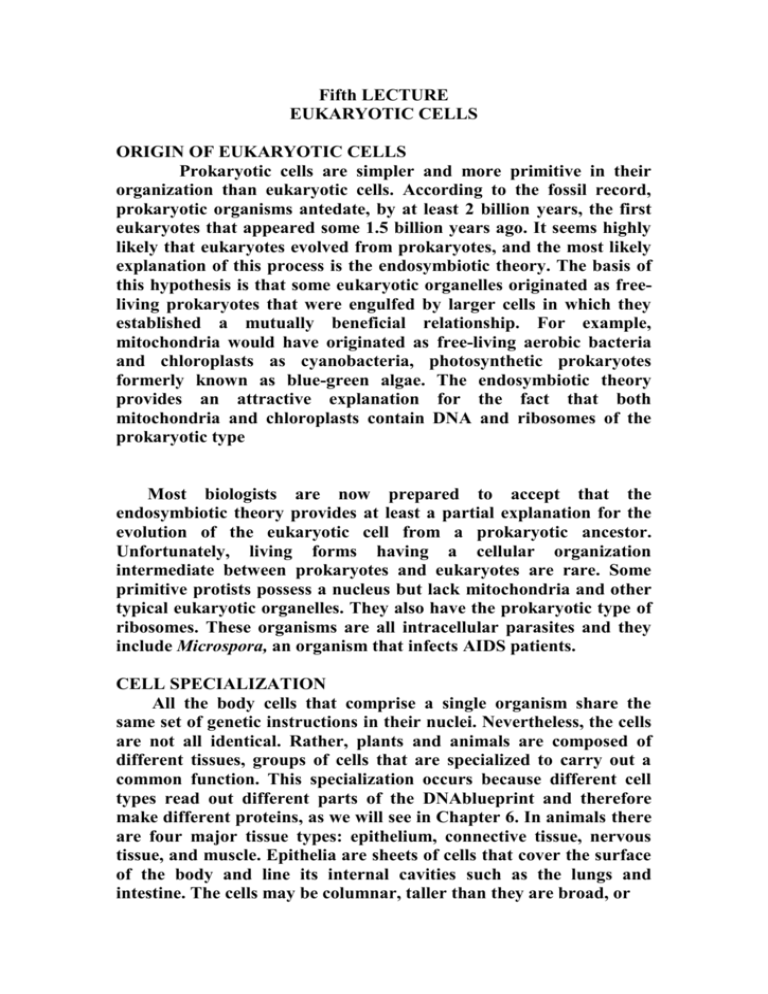
Fifth LECTURE EUKARYOTIC CELLS ORIGIN OF EUKARYOTIC CELLS Prokaryotic cells are simpler and more primitive in their organization than eukaryotic cells. According to the fossil record, prokaryotic organisms antedate, by at least 2 billion years, the first eukaryotes that appeared some 1.5 billion years ago. It seems highly likely that eukaryotes evolved from prokaryotes, and the most likely explanation of this process is the endosymbiotic theory. The basis of this hypothesis is that some eukaryotic organelles originated as freeliving prokaryotes that were engulfed by larger cells in which they established a mutually beneficial relationship. For example, mitochondria would have originated as free-living aerobic bacteria and chloroplasts as cyanobacteria, photosynthetic prokaryotes formerly known as blue-green algae. The endosymbiotic theory provides an attractive explanation for the fact that both mitochondria and chloroplasts contain DNA and ribosomes of the prokaryotic type Most biologists are now prepared to accept that the endosymbiotic theory provides at least a partial explanation for the evolution of the eukaryotic cell from a prokaryotic ancestor. Unfortunately, living forms having a cellular organization intermediate between prokaryotes and eukaryotes are rare. Some primitive protists possess a nucleus but lack mitochondria and other typical eukaryotic organelles. They also have the prokaryotic type of ribosomes. These organisms are all intracellular parasites and they include Microspora, an organism that infects AIDS patients. CELL SPECIALIZATION All the body cells that comprise a single organism share the same set of genetic instructions in their nuclei. Nevertheless, the cells are not all identical. Rather, plants and animals are composed of different tissues, groups of cells that are specialized to carry out a common function. This specialization occurs because different cell types read out different parts of the DNAblueprint and therefore make different proteins, as we will see in Chapter 6. In animals there are four major tissue types: epithelium, connective tissue, nervous tissue, and muscle. Epithelia are sheets of cells that cover the surface of the body and line its internal cavities such as the lungs and intestine. The cells may be columnar, taller than they are broad, or squamous, meaning flat. In the intestine, the single layer of columnar cells lining the inside, or lumen, has an absorptive function that is increased by the folding of the surface into villi The luminal surfaces of these cells have microvilli that increase the surface area even further. The basal surface sits on a supporting layer of extracellular fibers called the basement membrane. Many of the epithelial cells of the airways, for instance, those lining the trachea and bronchioles, have cilia on their surfaces. These are hairlike appendages that actively beat back and forth, moving a layer of mucus away from the lungs .Particles and bacteria are trapped in the mucus layer, preventing them from reaching the delicate air exchange membranes in the lung. In the case of the skin, the epithelium is said to be stratified because it is composed of several layers. The cilia on the epithelial cells that line our airways move a belt of mucus that carries trapped particles and microorganisms away from the lungs. These cilia are paralyzed by cigarette smoke. As a consequence, smokers have severely reduced mucociliary clearance with the result that they have to cough to expel the mucus that continuously accumulates in their lungs. Because of this impaired ciliary function, smokers are much more susceptible to respiratory diseases such as emphysema and asthma. The cilia of passive smokers, people who breathe smoky air, are also affected. Plant cells are also organized into tissues .The basic organization of a shoot or root is into an outer protective layer, or epidermis, a vascular tissue that provides support and transport, and a cortex that fills the space between the two. The epidermis consists of one or more layers of closely packed cells. Above the ground these cells secrete a waxy layer, the cuticle, which helps the plant retain water. The cuticle is perforated by pores called stomata that allow gas exchange between the air and the photosynthetic cells and also constitute the major route for water loss by a process called transpiration. Below ground, the epidermal cells give rise to root hairs that are important in the absorption of water and minerals. The vascular tissue is composed of xylem, which transports water and its dissolved solutes from the roots, and phloem, which conveys the products of photosynthesis, predominantly sugars, to their site of use or storage. The cortex consists primarily of parenchyma cells, unspecialized cells whose cell walls are usually thin and bendable. They are the major site of metabolic activity and photosynthesis in leaves and green shoots. SUMMARY 1. All living organisms are made of cells. 2. Our understanding of cell structure and function has gone hand in hand with developments in microscopy and its associated techniques. 3. Light microscopy revealed the diversity of cell types and the existence of the major organelles: nucleus, mitochondrion and, in plants, the vacuole and chloroplast. 4. The electron microscope revealed the detailed structure of the larger organelles and resolved the cell ultrastructure, the fine detail at the nanometer scale. 5. There are two types of cells, prokaryotes and eukaryotes. 6. Prokaryotic cells have very little visible internal organization. They usually measure 1–2 μm across. 7. Eukaryotic cells usually measure 5–100 μm across. They contain a variety of specialized internal organelles, the largest of which, the nucleus, contains the genetic material. 8. The endosymbiotic theory proposes that some eukaryotic organelles, such as mitochondria and chloroplasts, originated as freeliving prokaryotes. 9. The cells of plants and animals are organized into tissues. In animals there are four tissue types: epithelium, connective tissue, nervous tissue, and muscle. Plants are formed of epidermis, cortex, and vascular tissues. Cytosol. The plasma membrane is followed by the colloidal organic fluid called matrix or cytosol. The cytosol is the aqueous portion of the cytoplasm (the extranuclear protoplasm) and of the nucleoplasm (the nuclear protoplasm). It fills all the spaces of the cell and constitutes its true internal milieu. Cytosol is particularly rich in differentiating cells and many fundamental properties of cell are because of this part of the cytoplasm. The cytosol serves to dissolve or suspend the great variety of small molecules concerned with cellular metabolism, e.g., glucose, amino acids, nucleotides, vitamins, minerals, oxygen and ions. In all type of cells, cytosol contains the soluble proteins and enzymes which form 20 to 25 per cent of the total protein content of the cell. Among the important soluble enzymes present in the matrix are those involved in glycolysis and in the activation of amino acids for the protein synthesis. In many types of cells, the cytosol is differentiated into following two parts : (i) Ectoplasm or cell cortex is the peripheral layer of cytosol which is relatively non-granular, viscous, clear and rigid. (ii) Endoplasm is the inner portion of cytosol which is granular and less viscous. B. Cytoplasmic structures. In the cytoplasmic matrix certain nonliving and living structures remain suspended. The non-living structures are called paraplasm or inclusions, while the living structures are membrane bounded and are called organoids or organelles. Both kinds of cytoplasmic structures can be studied under the following headings : (a) Cytoplasmic inclusions. The stored food and secretory substances of the cell remain suspended in the cytoplasmic matirx in the form of refractile granules forming the cytoplasmic inclusions. The cytoplasmic inclusions include oil drops, triacylglycerols (e.g., fat cells of adipose tissue), yolk granules (or deutoplasm, e.g., egg cells), secretory granules, glycogen granules (e.g., muscle cells and hepatocytes of liver) and starch grains (in plant cells). (b) Cytoplasmic organelles. Besides the separate fibrous systems, cytoplasm is coursed by a multitude of internal membranous structures, the organelles (literally the word organelle means a tiny organ). Membranes close off at specific regions of the eukaryotic cells performing specialized tasks : oxidative phosphorylation and generation of energy in the form of ATP molecules in mitochondria; formation and storage of carbohydrates in plastids; protein synthesis in rough endoplasmic reticulum; lipid (and hormone) synthesis in smooth endoplasmic reticulum; secretion by Golgi apparatus; degradation of macromolecules in the lysosomes; regulation of all cellular activities by nucleus; organization of spindle apparatus by centrosomes and so forth. Membrane-bound enzymes catalyze Contents 60 CELL BIOLOGY reactions that would have occurred with difficulty in an aqueous environment. The structure and function of some important organelles are as follows: 1. Endoplasmic reticulum (ER). 2. Golgi apparatus 3. Lysosomes 4. Cytoplasmic vacuoles 5. Peroxisomes 6. Glyoxysomes. 7. Mitochondria 8. Plastids 9. Ribosomes 10.Microtubules and microtubular organelles Special Properties of Plant Cells Among eukaryotic cells the most striking difference is between those of animals and plants Plants have evolved a sedentary lifestyle and a mode of nutrition that means they must support a leaf canopy. Their cells are enclosed within a rigid cell wall that gives shape to the cell and structural rigidity to the organism (page 53). This is in contrast to the flexible boundaries of animal cells. Plant cells frequently contain one or more vacuoles that can occupy up to 75% of the cell volume. Vacuoles accumulate a high concentration of sugars and other soluble compounds. Water enters the vacuole to dilute these sugars, generating hydrostatic pressure that is counterbalanced by the rigid wall. In this way the cells of the plant become stiff or turgid, in the same way that when an inner tube is inflated inside a bicycle tire the combination becomes stiff. Vacuoles are often pigmented, and the spectacular colors of petals and fruit reflect the presence of compounds such as the purple anthocyanins in the vacuole. Cells of photosynthetic plant tissues contain a special organelle, the chloroplast, that houses the light- harvesting and carbohydrate-generating systems of photosynthesis. Plant cells lack centrosomes although these are found in many algae.

